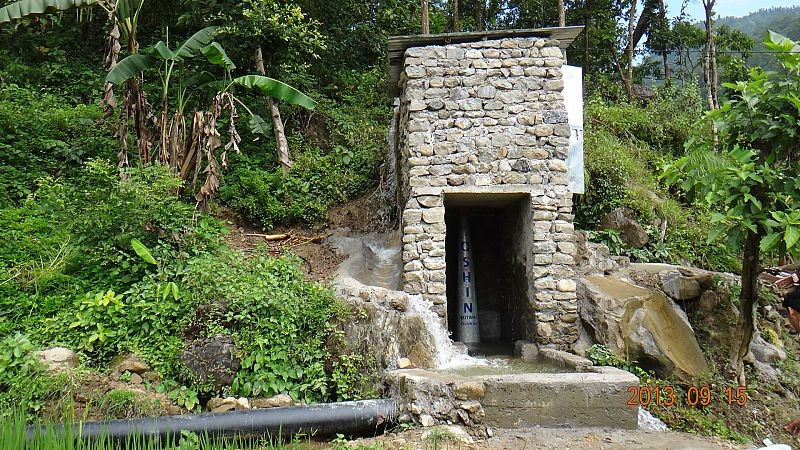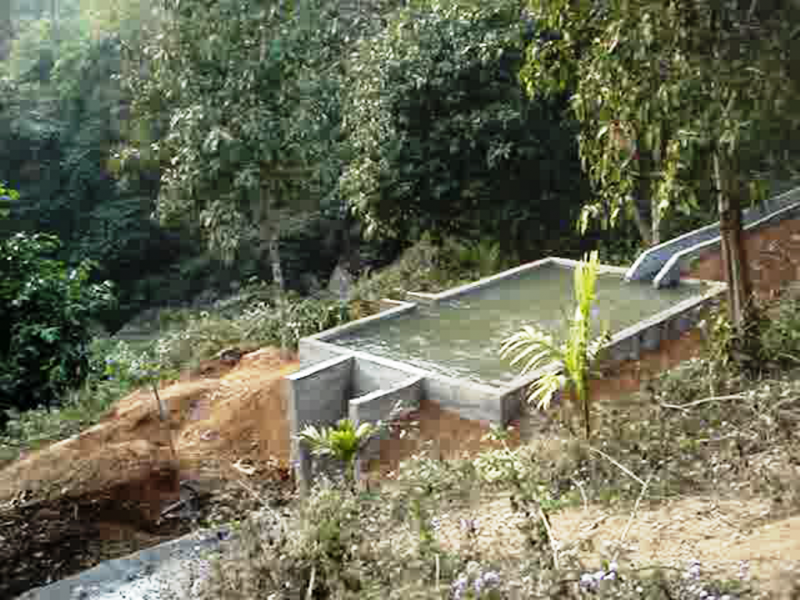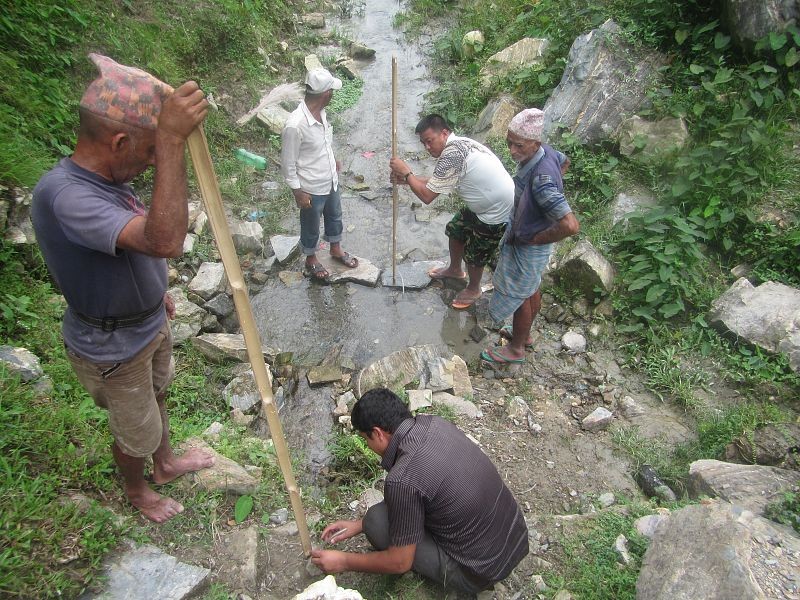To demonstrate feasibility of a low-head propeller turbine in low-lying unelectrified communities
Nepal has been promoting the use of micro-hydro and pico-hydro technologies for over four decades as a means of reaching its energy access goals. However, most of the designs used require a head (height difference between the water entry into the hydro system) of more than 10 meters. Consequently, hundreds of unelectrified communities in low-lying areas of Nepal with suitable water flow but low head are not benefitting from the potential of micro-hydro.
Prior to this project, PEEDA had successfully customised a low-head propeller system and installed 1 kW units in various communities, as well as completing the design of a 3 kW unit. This project allowed PEEDA to further test the system at two sites in the Okhaldhunga district (Molung Doban in the Toksel municipality and Solung Besi in Katunje). The project placed emphasis on engaging heavily with the communities and ensuring that they continue to see benefits from the technology over the long term.

TECHNOLOGY, OPERATIONS & MAINTENANCE
In the first phase of the project, a baseline study was conducted to gather data on demographics, energy use and site characteristics required for the technical design. With the help of this information, two units were designed:- One 1 kW unit, requiring 3.6 metres head and a water flow of 60 litres per second, supplying electricity to 15 households.
- One 1.5 kW unit, requiring 4.5 metres head and a water flow of 80 litres per second, supplying electricity to 16 households.
DELIVERY MODEL & FINANCIAL MANAGEMENT
The two sites are based on a COCO (Community Owned and Community Operated) model. To create a sense of project ownership and ensure long-term sustainability, the project focused on community mobilisation and involvement from the outset.
User committees were formed to represent the community interests for each of the sites and to liaise with PEEDA and its partners during the implementation phase. The committees also took care of legal and administrative issues, such as the registration of the scheme at the district offices and the setting up of a bank account.
The communities contributed manpower and local materials for the construction of civil works, and beneficiary households pay a monthly tariff to cover maintenance of the system. Tariffs are higher for households with TVs and refrigerators. Moreover, individual households are responsible for the day-to-day care of the system on a rotational basis. Two operators per site were trained to handle minor technical faults.
ENVIRONMENTAL ISSUES
In the project region, almost 50 % of households use kerosene for lighting for 2 to 3 hours daily, with an average consumption of 1.64 litres per month per household. By replacing kerosene with renewable electricity for lighting, the project avoided greenhouse gas emissions and the environmental impacts of transporting kerosene, as well as reducing the fire risks associated with the use of kerosene lamps.
Efforts were made to ensure the use of water from the irrigation canals did not affect local landowners. While the building of new canals to direct the water from the irrigation canals to the turbines had a minimal impact on the landscape, the cabling was built without any disturbance to natural vegetation.
No negative impact on the downstream waterflow was observed and the improved maintenance of the irrigation canal appears to have had a positive impact on agricultural production.
SOCIAL ISSUES
The communities were heavily involved in all stages of the project implementation and received training in the operation, maintenance and financial management of the systems. For example, some community members were trained in the wiring of the houses and they went on to complete the wiring themselves and to deal with minor maintenance issues. Other members were trained in basic accounting. Several women took executive roles in the user committees, giving them a greater say in decision making.
The availability of affordable electricity has positively impacted livelihoods in various ways; for example, by extending the hours of lighting available for education and by facilitating the charging of mobile devices and radios – thereby increasing connectivity in the area.
RESULTS & IMPACT

The direct outcome of this project is the provision of regular and reliable lighting to houses and streets within the communities. Moreover, it powers appliances for households that can afford them and has also helped to expand one local business. At the time of reporting, only 4 of the 31 households had a television and one shop had a refrigerator. By using energy-efficient LED lights, the power currently provided could potentially accommodate additional demand – such as further appliances in the participating communities or lighting for neighbouring communities.
The project also successfully demonstrated pico-hydro technology in an area where it could have significant potential for replication. When the units faced technical problems (e.g. with the electric load controller of the larger unit) this provided an opportunity to improve the systems and adapt them to the specific needs of each site. No further issues have since arisen. Attending to these problems promptly was key to keeping the community involved and positive about the project.
REPLICABILITY
There are many rural locations with similar topographic and water resource characteristics in both Nepal and in neighbouring countries, which highlights the potential for replicating this project design. PEEDA has shared its experience with its partner organisations in Bhutan, Bangladesh and India through a professional exchange programme and articles on the project have been published in PEEDA’s annual magazine and distributed to its members and related organisations. Moreover, PEEEDA shared this success story at the “Hydro Empowerment Asia” annual conference in Kathmandu in November 2016.
Due to its role in this project, PEEDA was commissioned by the Nepalese Alternative Energy Promotion Center (AEPC) to carry out a feasibility study of potential pico-hydro sites. The results of the project have also motivated nearby communities to install similar units.
LESSONS LEARNED
The community engagement and capacity building component of the project proved essential for its success and sustainability. The use of energy-efficient LED lights and existing irrigation canals were also key to the technical and financial feasibility of the project. Some of the challenges included transporting heavy electro-mechanical components to remote communities across rough terrain and motivating the local community to dedicate sufficient time on a regular basis for the civil construction works. These and other lessons have been incorporated into PEEDA’s continued dissemination and advocacy efforts in Nepal.
Projects with same technology
Establishment of Demand-Driven Sustainable Improved Watermill Cluster in the State of Uttarakhand, India
This project aims to improve the traditional water mills by replacing wooden equipment in order to make them more efficient and to demonstrate the importance of the technology in the mountainous region. Furthermore, the supply and demand gap of products (such as grains) processed by the water mills could be closed by efficient production and effective marketing.
Exchange: Knowledge and Advocacy for Productive End Use of Micro Hydro Projects
This exchange activity aims to contribute to the sustainability of micro hydro plants in Southern and Southeast Asia by increasing the load factors and financial bases through the implementation of proven best practices for productive end uses.
Projects in same country